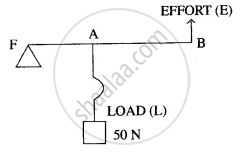Advertisements
Advertisements
प्रश्न
A man uses a crowbar of length 1.5 m to raise a load of 75 kgf by putting a sharp edge below the bar at a distance 1 m from his hand.
- Draw a diagram of the arrangement showing the fulcrum (F), load (L) and effort (E) with their directions.
- State the kind of lever.
- Calculate:
- load arm,
- effort arm,
- mechanical advantage and
- the effort needed.
उत्तर
(a)

75 kgf. crow bar
Effort = ?
M.A. = `"L"/"E"`
2 = `("75 kgf")/"E"`
E = `75/2`
E = 37.5 kgf
(b) Class I lever
(c)
- Load arm 1.5 – 1.0 = 0.5 m
- Effort arm = 1 m
- Mechanical advantage = `1.0/0.5 = 2`
APPEARS IN
संबंधित प्रश्न
shows a nut cracker name the class of lever ?
The lever for which the mechanical advantage is less than 1 has :
Fig 3.17 below shows a lever in use.

(a) To which class of lever does it belong?
(b) If FA = 80 cm, AB = 20 cm, find its mechanical advantage.
(c) Calculate the value of E.
A lever of length 9 cm has its load arm 5 cm long and the effort arm is 9 cm long.
- To which class does it belong?
- Draw a diagram of the lever showing the position of fulcrum F and directions of both the load L and effort E.
- What is the mechanical advantage and velocity ratio if the efficiency is 100%?
- What will be the mechanical advantage and velocity ratio if the efficiency becomes 50%?
The following belong to which class of lever?
A fire tongs
The following belong to which class of lever?
Fore-arm
The diagram below shows a lever in use.

(i) To which class of lever does it belong?
(ii) If FA = 40 cm, AB = 60 cm, then find the mechanical advantage of the lever.
The length of a nut-cracker is 12 cm. A nut, when kept at a distance of 4 cm from its fulcrum, requires an effort of 100 gf to crack it. What force will be required to crack the nut without using the nut-cracker?
What is a first-order lever?
A lever is used to multiply the force.
